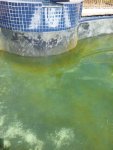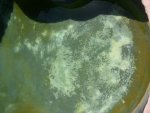Bought this house two years ago. The house was built 25 years ago, the pool may be built at the same time or later. I regularly put two 1-pound bags of pool store shocks every two or three weeks and add a block of the 2-inch-diameter-1-inch-thick chlorine granule in the return line container every week.
The algae became out of control this spring and summer. I found this site and started to read. I thought the problem is too high CYA after reading. I bought the TF100 test kit last week, the following is the test results.
CYA:250+
TA: 190
PH:>8.2
CH:1250
Chlorine level: < 0.5
Before I bought the test kit, I have already suspected that CYA may be too high and I am ready to drain the pool, so I stopped to put more shocks or chlorine granules. I guess that may be the reason of low chlorine level (<0.5ppm).
Started to drain yesterday, I plan to stop when 5/6 of water is gone. Thus after refill, I will expect that CYA and CH to be ~40 and ~120. I then will do a SLAM after the refill to get rid of algae. Am I right on this plan? The color of the algae is yellowish, is this type very hard to deal with? Should I expect weeks of high FC and brushing when SLAMing the pool?
While the pool is drained, I think I may be able to do something for the pool surface. As I have noticed that the pool does have scale problem due to too high CH for so many years. I have attached a picture that shows the scale accumulation on the tile surface on the path from the spa to the pool. Can I do something to get rid of this scale while the pool is drained?
The pool plaster surface may be another issue. I don’t know if it is normal for the plaster surface or it is a really serious problem. The surface color is uneven and non-uniform with grey color scattered in dark color. Is this because the last layer of plaster starts to come off or is this because the paining comes off? I can’t tell if the surface is colored plaster or painted surface. I have also attached a picture about this. Can I do something about the surface while the pool is drained? Does the surface really need to be re-plastered or can I paint the surface?
I am not sure if my question makes sense. But thanks so much for help. TG


The algae became out of control this spring and summer. I found this site and started to read. I thought the problem is too high CYA after reading. I bought the TF100 test kit last week, the following is the test results.
CYA:250+
TA: 190
PH:>8.2
CH:1250
Chlorine level: < 0.5
Before I bought the test kit, I have already suspected that CYA may be too high and I am ready to drain the pool, so I stopped to put more shocks or chlorine granules. I guess that may be the reason of low chlorine level (<0.5ppm).
Started to drain yesterday, I plan to stop when 5/6 of water is gone. Thus after refill, I will expect that CYA and CH to be ~40 and ~120. I then will do a SLAM after the refill to get rid of algae. Am I right on this plan? The color of the algae is yellowish, is this type very hard to deal with? Should I expect weeks of high FC and brushing when SLAMing the pool?
While the pool is drained, I think I may be able to do something for the pool surface. As I have noticed that the pool does have scale problem due to too high CH for so many years. I have attached a picture that shows the scale accumulation on the tile surface on the path from the spa to the pool. Can I do something to get rid of this scale while the pool is drained?
The pool plaster surface may be another issue. I don’t know if it is normal for the plaster surface or it is a really serious problem. The surface color is uneven and non-uniform with grey color scattered in dark color. Is this because the last layer of plaster starts to come off or is this because the paining comes off? I can’t tell if the surface is colored plaster or painted surface. I have also attached a picture about this. Can I do something about the surface while the pool is drained? Does the surface really need to be re-plastered or can I paint the surface?
I am not sure if my question makes sense. But thanks so much for help. TG



